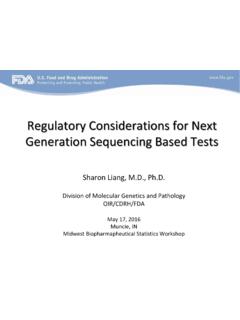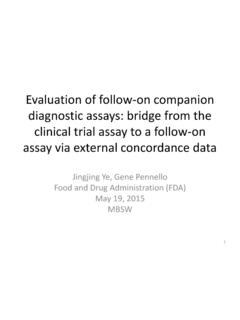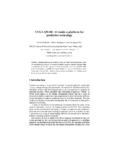Transcription of Regulatory Perspective for Companion Diagnostics
1 Regulatory Perspective for Companion DiagnosticsThe 38thAnnual Midwest Biopharmaceutical Statistical Workshop (MBSW)May 19, 2015 Jennifer Shen, , RACFood and Drug Administration (FDA)Center for Devices and Radiological Health (CDRH)Office of In Vitro Diagnostics and Radiological Health (OIR)Division of Immunology and Hematology Devices (DIHD) Hematology and coagulation tests Tests for immunological disease Flow cytometryDivision of Chemistry and Toxicology Devices (DCTD) General and specialized chemistry tests ( , neonatal biochemical screening tests, endocrine tests, and tests for women's health) Drug of abuse tests Therapeutic drug monitoring testsDivision of Microbiology Devices (DMD) Detection of microorganisms (bacteria, fungi, mycobacteria, viruses) by chemical, immunological, and nucleic acid amplification methods Biothreat agents New and emerging infectious diseasesDivision of Molecular Genetics and Pathology (DMGP) Oncology Companion diagnostic tests Genetic disorder (heritable somatic mutations)
2 Tests Pathology and cytologyFDA CDRH OIR2 Division of Mammography and Quality Standards (DMQS) Implements the Mammography Quality Program authorized by the Federal Mammography Quality Standards Act of 1992 Division of Radiological Health (DRH) Diagnostic radiology devices Radiation therapy devices Medical and non-medical electronic product radiation control ( ultrasound productsPresentation Topics Background FDA Review of Companion Diagnostics (CoDx) Current Status and Recent Approvals Emerging Issues and Challenges Follow-on CoDx3 Personalized Medicine The success of personalized medicine depends on having accurate, reproducible and clinically useful Companion diagnostic tests to identify patients who can benefit from targeted therapies Companion Diagnostics (CoDx) are those tests that provides information that is essentialfor the safe and effective use of a corresponding drug or biological product4 FDA Expectation for CoDx Guidance for Industry and FDA Staff.)
3 In Vitro Companion Diagnostic Devices Guidance finalized August 6, 2014 Defines Companion diagnostic device and various scenarios for use Describes FDA policies for approval and labeling Contemporaneous Regulatory approvals of the device and therapeutic product Development Trend Dramatic increase in biomarker-targeted drug development programs In the early 1990s, 5% of new drug approvals were for targeted therapies In 2013, 45% were for targeted therapies Increase in use of tests to detect/measure biomarkers to identify the Intent-To-Treat (ITT) population 6 Why Companion Diagnostics Companion Diagnostics segregate a patient population into two subsets: marker-positive vs.
4 Marker-negative a qualitative result based on an underlying semi-quantitative / quantitative assessment to which a clinical decision point or cut-offis applied The safety and efficacy of the therapeutic product is evaluated in the population that is treated in the clinical trial, , marker-positive study marker-positive: enrolled, safety and efficacy evaluated marker-negative: not enrolled, safety and efficacy not evaluated Leading to more focused therapies that offer better outcomes and less toxicity to patients7 CoDx Policy Co-approval of a test and corresponding drug required when the test is essential for safe and effective use of the therapeutic product CoDx requirement Decision made by drug review division Device Center provides insight Labeling Therapeutic label refers to FDA approved Test Device label names the drug8 Business Issues Therapeutic product sponsors are responsible for assuring that a Companion
5 Diagnostic (CoDx) device will be brought forward Device sponsors are responsible for CoDx submission, performance, compliance with device regulations Therapeutic product and CoDx sponsors should carefully define expectations for each other9 Presentation Topics Background FDA Review of Companion Diagnostics (CoDx) Current Status and Recent Approvals Emerging Issues and Challenges Follow-on CoDx10 FDA Review for CoDx Intended Use / Indications for Use Device Description (reagents, platform ) Pre-analytical Analytical Performance Clinical Performance Instrumentation, Software validation (as applicable) Labeling (package insert)1111 Overview of CoDx Validation The test is used to select target population enrolled in the therapeutic clinical trial In Vitro Companion Diagnostic Devices (IVD CoDx) A specific test is identified for detecting the marker A specific protocol is used with the test A clinical decision point (cut-off)
6 Is selected A specific specimen type is identified for testing 12 Overview of CoDx Validation Analytical validation ( , accuracy, reproducibility, specificity, stability) is obtained with attention to the clinical decision point Clinical validation of the device is supported by results of the therapeutic clinical trial13 When the CoDx is not the Clinical Trial Assay (CTA) Changing the test ( , technology platform ) can change the results for a patient s specimen, and potentially changes the patient population from what was selected in the therapeutic clinical trial Requires Bridging Studies A bridging study is not just a method comparison To show that the revised test (IVD CoDx) supports safety and efficacy of the therapeutic product14 Bridging Studies Re-test patient specimens (CTA negative and positive)
7 With new/revised test to support safety and efficacy of the therapeutic product Re-test population is representative of the intended use population for the device Statistical Analysis Plan should consider discordance, missing samples, address bias and impact on therapeutic product efficacy15 Presentation Topics Background FDA Review of Companion Diagnostics (CoDx) Current Status and Recent Approvals Emerging Issues and Challenges Follow-on CoDx16 CoDx Current StatusTo date: 21 different approved drug/diagnostic combinations All (except one) are for oncology indications Many are HER-2 specific Others are novel agents/new tests CoDx Approvals18 TherapeuticIVD DeviceDevice ManufacturerErbitux (cetuximab)Vectibix (panitumumab)cobas KRAS Mutation TestRoche Molecular Systems, (olaparib)BRACA nalysis CDxMyriad Genetic Laboratories, (afatinib)therascreenEGFR RGQ PCR KitQiagen Manchester, (erlotinib)cobas EGFR Mutation TestRoche Molecular Systems, (cetuximab)Vectibix (panitumumab)
8 TherascreenKRAS RGQ PCR KitQiagen Manchester, LtdXalkori (crizotinib)VYSIS ALK Break Apart FISH Probe KitAbbott Molecular (tramatenib)Tafinlar (dabrafenib)THxID BRAF KitbioM rieux (vemurafenib)cobas 4800 BRAF V600 Mutation TestRoche Molecular Systems, Approvals in 2014 QIAGEN therascreenKRAS RGQ PCR kit: aid in the identification of colorectal cancer patients for treatment with erbitux (cetuximab) and vectibix(panitumumab) based on a KRAS no mutation detected test result. Myriad BRACA nalysis CDx : aid in identifying ovarian cancer patients with deleterious or suspected deleterious germline BRCA variants eligible for treatment with Lynparza (olaparib).
9 To be performed only at Myriad Genetic Laboratories, a single laboratory site located at 320 Wakara Way, Salt Lake City, UT 8410819 BRACA nalysis CDxDevice includes the following: Sample collection kit BRACA nalysis CDx Sanger sequencing test BRACA nalysis CDx Large Rearrangement Test (BART CDx) Alternate Primer Sequencing (APS) Confirmatory PCR Analysis (CPA) Defined variant classification process The test is intended to be performed at a single laboratory site20 Regulatory Breakthroughs First LDT approved as CoDx First CoDx approved without a list of specified variants.
10 Instead, variant classification process approved as part of the test. Types of variants are included in the labeling First CoDx approved with conditions Perform additional analytical testing Report results from ongoing confirmatory trials Provide updates on variant classification process Monitor and report on robustness of classification process21 BRACA nalysis CDx Case Study FDA and Sponsors Collaborative Efforts Accelerating Anticancer Agent Development and Validation Workshop (AAADV) May 6 - 8, 2015, Bethesda, MD DIA Meeting on Companion Diagnostics September 30 October 1, 2015, Bethesda, MD Topics Background FDA Review of Companio


